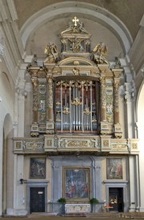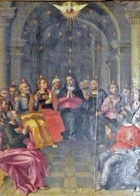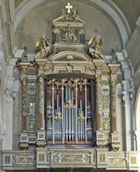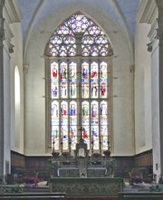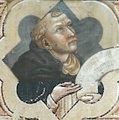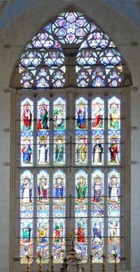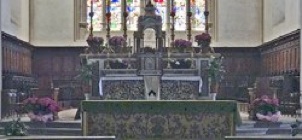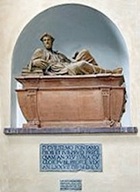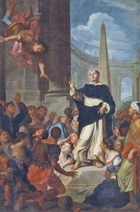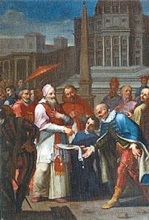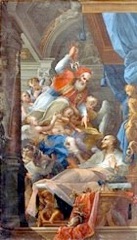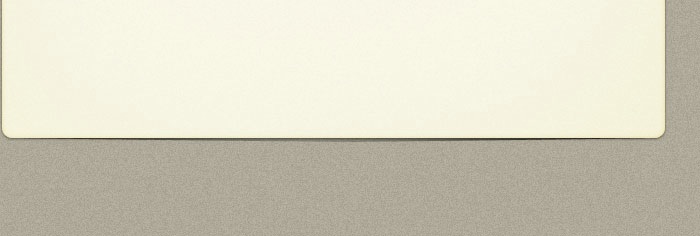The church was built in the form of a “Hallenkirche” (hall church), so-called because the nave and flanking aisles are of equal height. The nave leads to the crossing, which was built at in the middle of the 14th century on the site of the earlier church of San Stefano del Castellare. Beyond is the rectangular apse, with two apsidal chapels to each side.
Gothic Church
The tour begins in the last bay of the nave, and proceeds clockwise around the crossing. This part of the church largely escaped the collapse of 1614 and was restored in the early 20th century. It therefore preserves some of the original Gothic features. Some of the original capitals of the columns have been exposed in the crossing.
Cappella di Santa Caterina
This chapel (the 5th in the left aisle, just before the crossing) seems to have been built in the early 15th century to form the base of the campanile. (A chapel with this dedication that was documented in 1325, but it seems that this was either demolished to make or way for it or that it was located elsewhere).
The Blessed Colomba da Rieti was buried under the altar of this chapel in 1501. [Are her relics still here ??]
Frescoes (ca. 1415)
St Peter Martyr preaching St Catherine before St Catherine converts
before the Emperor the Empress
The frescoes, which were recovered from under plaster in 1911, include two of the most complete (albeit damaged) pictorial cycles that survive in Perugia. These two cycles depict:
-
✴scenes from the life of St Peter Martyr (on the back wall), and
-
✴scenes from the life of St Catherine of Alexander (on the left).
Related frescoes were discovered in the vaults in 1920-2, together with the arms of Menico di Marino. Still more frescoes (mostly standing figures of saints) adorn the pilasters.
Giorgio Vasari named a number of Florentine artists whom he believed had worked in the chapel:
-
✴ “..at Perugia, .... in the Chapel of the Buontempi in the Church of San Domenico .... [Buonamico Buffalmacco (died after 1336)] painted there in fresco .... stories of the life of S. Catherine, virgin and martyr”.
-
✴“At Perugia ..., in the Church of San Domenico, [Stefano Fiorentno (died after 1350)] began in fresco the Chapel of Sant Caterina, which remained unfinished”.
-
✴“[Taddeo di Bartolo (died 1422)] was called to work at Perugia in the Church of San Domenico, where, in the Chapel of S. Caterina, he painted in fresco all the life of that Saint. .... A little time afterwards there befell the death of [Biordo Michelotti], Lord of Perugia, who was murdered in the year 1398; whereupon Taddeo returned to Siena ...”
The last of these attributions has historically been accepted. However, modern scholars mostly attribute all of the frescoes to Benedetto di Bindo. (He is documented in San Domenico in 1415 and was buried here when he died prematurely two years later).
Left Transept
There are two doors in the back wall of the left transept leads:
-
✴the door on the left leads to the sacristy (below); and
-
✴the door on the right opens onto a small chapel that contains a permanent model of the Nativity.
The arch in the left wall opens onto the Cappella di Santa Caterina (above).
The monument of Gugliemo Pontano (1478-1555), which was recorded in 1597 above the door to the sacristy, is now in the right transept (see below).
Altare della Pentecoste (1554-5)
Gugliemo Pontano commissioned this altar, which was completed after his death. Its design is attributed to
Vincenzo Danti.
Pentecoste (ca. 1554)
Gugliemo Pontano also commissioned the altarpiece, which is signed the Florentine Dominican nun,
Plautilla Nelli. It depicts the descent of the Holy Spirit to the Virgin and the Apostles after the Crucifixion and Resurrection of Christ.
Panels (1630)
According to local historians, Antonio Maria Fabrizi decorated the newly-designated Cappella del Rosario (the inner apsidal chapel on the right - see below) in 1630. His frescoes here were destroyed when the chapel was restored in 1956. The two panels from the side walls, which are attributed to him, are now to the sides of the Altare della Pentecoste. They depict:
-
✴the martyrdom of St Dorothy; and
-
✴SS Cecilia and Valerian.
Organ (1638-41)
The organ was built by Luca Neri da Leonessa. The casing was built in 1660, at which point the organ was restored by Angelo Mattioli da Perugia. The gilding of the casing was completed only in 1748. The organ was restored again in 1870 by
Angelo and
Nicolò Moretti.
Cappella degli Angeli
This chapel (the outer apsidal chapel on the left) is now the Cappella di San Tommaso.
Martyrdom of SS Peter Martyr and Sebastian (1396)
These well-preserved frescoes, which are dated, flank a niche in the right wall. The fresco to the left, which depicts the murder of St Peter martyr is attributed to Cola Petruccioli.
Frescoes (14th and 15th centuries)
The frescoes on the left wall include:
-
✴at the top left, the stigmatisation of a female saint (almost certainly St Catherine of Siena) by a seraph on a cross (dated 1368), which employs an iconography usually reserved for St Francis; and
-
✴at the bottom left, the Madonna and Child and SS Lucy and James (dated 1370), which is attributed to the Maestro di Santa Giuliana.
Ecstasy of St Thomas Aquinas (18th century)
This panel on the altar is by Mattia Batini.
Cappella di San Nicolò
This chapel (the inner apsidal chapel on the left) is now the Cappella del Nome di Gesù. It is documented in 1382 as the chapel in which Alberto di Nino di Lello Guidalotti wished to be buried here, and it had probably belonged to this family since its inception. Alberto and his direct descendants were the only members of his family to escape the retribution that followed the murder of Biordo Michelotti by Francesco Guidalotti in 1398.
Alberto died in 1390. His son Benedetto Guidalotti pursued a career at the court of Pope Martin V and was made Bishop of Recanati. He returned to Perugia in 1428, a year before his death and was buried in the family chapel (see below). Benedetto’s sister, Elisabetta, who had married Bartolomeo di Onofrio Bartolini, maintained the family fortunes in Perugia. She commissioned his monument in the family chapel as well as the so-called Guidalotti Polyptych (1447-9) by Fra Angelico (which is described in the page of art removed from San Domenico) for its altar.
Elisabetta Guidalotti also commissioned a monument on the right wall for her husband, who died in 1441, and she was buried here after her death in 1460. Unfortunately, no trace of this monument survives.
Frescoes of the Evangelists (14th century)
These frescoes in the vault are attributed to
Allegretto Nuzi. They are damaged, although the figure of St John remains legible.
Monument to Benedetto Guidalotti (1429)
Elisabetta Guidalotti probably commissioned this monument for her brother, Bishop Benedetto Guidalotti of Recanati. It has been moved on a number of occasions and what survives of it is now on the left wall of the chapel. This comprises an effigy of the deceased in his episcopal robes on a sarcophagus decorated with reliefs of the Theological Virtues. The inscription at its centre has been lost.
Circumcision of Christ (17th century)
This altarpiece on the altar of the chapel is the only known work by
Giuseppe Berrettini, a nephew of
Pietro da Cortona.
Martyrdom of St Ursula (17th century)
This panel, which is on the right wall, is attributed to
Simeone Ciburri. It was execute for the adjacent Cappella degli Angeli but subsequently moved here.
Apse
Frescoes (ca. 1400)
St Thomas Aquinas Self-portrait (?)
The surviving fresco fragments on the left wall of the apse were probably part of a Marian cycle that covered all the walls of the apse. They are attributed to Cola Petruccioli. The survivals include the lower part of what seems to have been an Annunciation and a frieze below it that contains the two details illustrated above. [These fragments were still in restoration at the time of my visit in April 2014.]
Stained glass windows (1411)
These important stained glass windows are signed by
Mariotto di Nardo da Firenze and Fra
Bartolomeo di Pietro da Perugia (who respectively designed the scenes and executed them) and dated by inscription. The stemma of the Graziani family in the bottom register suggests that this family were the donors of the work. The scenes of the miracles of St James in this register underline the importance of San Domenico as a pilgrimage church.
The windows were dismantled in 1860 and stored in packing cases. Fortunately, Francesco Moretti intervened to restore and re-assemble them over the period 1861-79. Another restoration was recently completed. The individual scenes in the windows are illustrated in the site of the Archivio Centro Culturale S. Tommaso d’Aquino, Perugia.
Choir Stalls (1476-98)
Crispolto di Polto da Bettona and his assistants began work on the choir stalls in 1476.
Antonio Bencivenni da Mercatello was charged with the completion of the project in 1498. The stalls were restored in 1911.
Monument to Bishop Vincenzo Ercolani (1586)
This monument on the back wall of the apse (underneath the stained glass windows) commemorates
Vincenzo Ercolani. He became bishop of his native Perugia in 1579 and died here seven years later (although the monument incorrectly gives the date of his death as 1581). Although he had wished to be buried at San Domenico, Fiesole, where he had first entered the Dominican Order, he was actually buried here.
High Altar (1720)
Pietro Carattoli designed the high altar and its ciborium in 1720. It was completed some time later, and not exactly according to the design. The sculpted relief of a pelican opening her beak to feed her young (an allegory of Christ the Redeemer) on the frontal seems to have been reused from another structure. Steps behind the altar lead up to the urn that contains the relics of the founders of the convent, Fra. Nicolò da Giovinazzo and Fra. Tomasello da Perugia.
Cappella degli Apostoli
This chapel (the inner apsidal chapel on the right) was re-dedicated as the Cappella del Rosario in 1630. It was restored in 1956, at which point its frescoes by Antonio Maria Fabrizi were destroyed. Panels from this chapel were moved at that point to the left transept (above) and to altars in the nave (see below).
The chapel was re-dedicated as the Cappella di Beato Benedetto IX in 1959, when the
Monument of Pope Benedict XI was installed here. A reliquary containing some of the relics of Benedict XI is housed in a niche on the back wall.
The inscription on the back wall records the consecration of the church by Pope
Pius II in 1459.
Frescoes (14th century)
These frescoes in the vaults are damaged, although the figures of SS Peter (left above) and Dominic remain legible. The other two were probably SS Augustine and Paul.
Cappella di San Tommaso
This chapel (the outer apsidal chapel on the right) is now the Cappella di San Pietro Martire.
Fresco fragments (14th and 15th centuries)
Three groups of fresco fragments survive on the left wall:
-
✴Those on the left depict: St Antony Abbot above and two figures below (illustrated above, to the left):
-
•St Michael reconciling two nobles; and
-
•St Dominic.
-
✴The fragments on the upper right, which almost certainly formed a Crucifixion with the Virgin and St John the Evangelist, include a fine head of Christ (illustrated above).
-
✴Those on the lower right (illustrated above, to the right) depict:
-
•St Mary Magdalen as a hermit, clothed only in her long hair;
-
•St Bartholomew holding the knife with which he was skinned alive; and
-
•St Christopher with the Christ Child on his shoulder.
-
✴The votive frescoes on the right wall are more complete. They include this fine Madonna and Child on the lower left, in which the baby Jesus offers a lily to His mother, that is by a
follower of the Maestro del 1421.
Death of St Peter Martyr (1705)
The inquisitor Fr. Paolo Ottaviani commissioned this altarpiece from
Giovanni Ventura Borghesi in 1705. It is based on the now-lost altarpiece (1528-30) by Titian in the Dominican church of SS Giovanni e Paolo, Venice.
Crossing
Monument to the Danti Family (1576)
This monument on the left pilaster of the apse commemorates a number of members of the Danti family, including:
-
✴three identified in the upper inscription:
-
•the sculptor Vincenzo Danti (died 1576);
-
•the architect and goldsmith Giulio Danti (died 1575), Vincenzo’s father; and
-
•the Dominican mathematician Ignazio Danti (died 1586), Vincenzo’s brother; and
-
✴the artist Girolamo Danti (died 1580), Vincenzo’s brother, who is identified on the inscription below.
The marble bust at the top of the monument was documented in 1597. It has been identified as a portrait (1576) of Vincenzo Danti by Valerio Cioli. (The two men had worked together in Florence).
Bust of Elisbetta Cantucci (1648)
Baldo Coli commissioned this fine bust as part of the funerary monument of his wife, Elisbetta Cantucci. The monument is lost but the relief is now on the right pilaster of the apse. It is traditionally attributed to
Alessandro Algardi, although modern scholars tend to attribute it to one of his followers.
Bust of Alessandro Benincasa (1694)
Michelangelo Benincasa commissioned this bust from
Giovanni Domenico Guidi to commemorate his brother,
Alessandro Benincasa, who came from Perugia and who had a successful legal and ecclesiastical career in Rome. He died there, but his heart preserved below the bust, on the pilaster opposite the right pilaster of the apse.
Cappella di San Domenico
This chapel (at the end of the right transept) was built in the mid-15th century for the Perugian merchant Francesco di Pietro.
Relief of the Compagnia della Croce (1436)
This stone relief is on the back wall of the transept, to the left of the entrance to the chapel. It depicts two kneeling members of this penitent confraternity holding a cross and symbols of the apocalypse.
Ex-Cappella di San Pietro Martire
This chapel (on the right of the right transept) was part of the original construction of the church. Before the side door was built as part of the 18th century, it was enclosed by walls with openings into the transept and the nave, like the Cappella di Santa Caterina opposite.
Monument to Gugliemo Pontano (ca. 1555)
Gugliemo Pontano (1478-1555) was a celebrated jurist and professor who lived and worked in a house near Sant’ Ercolano (see
Walk IV). He had acted as an ambassador to the court of Pope Clement VII. His monument was recorded in 1597 in the left transept (above the door to the sacristy - see above) and attributed to
Vincenzo Danti. It is now on the wall to the left of the side entrance of the church, which was originally the right wall of the Cappella di San Pietro Martire.
The fine terracotta reclining figure of the deceased on the sarcophagus is extraordinarily animated. It was probably originally covered in white stucco so that it seemed to be made of marble.
Cappella di San Lorenzo (15th century)
This Renaissance chapel (the 4th in the right aisle), which is now known as the Cappella della Madonna del Voto, is described on a separate page with its original dedication as the Cappella di San Lorenzo.
Rest of the Church
The nave of the church was rebuilt in 1614.
The first four chapels on the left and the first three on the right were added in the middle of the 18th century.
Gonfalon (1494)
This banner by
Giannicola di Paolo in the Cappella del Gonfalon (
the 3rd on the left of the nave) is documented in the process for the canonisation of the
Blessed Colomba da Rieti in 1630. It seems that the Blessed Colomba advised the citizens of Perugia to pray for the protection of SS Dominic and Catherine of Siena as plague raged in the city in 1494, and the city magistrates consequently commissioned this processional banner. By 1630, it was in the Cappella del Rosario of
San Domenico Vecchio. It is now used as the altarpiece of is the Cappella del Gonfalone
(3rd on the left). Its original wooden frame, in which it was carried in processions, is on the left wall of the Cappella di San Vincenzo Ferreri
(2nd on the left).
The altarpiece depicts SS Dominic and Catherine of Siena protecting Perugia from the arrows of angels. Above, Christ sits in judgement, flanked by the Virgin and SS John the Baptist, Sebastian, Andrew, Laurence and (probably) Herculanus. Perugia is represented by a group of citizens and a fine cityscape, The female Dominican in prayer, to the left of St Catherine of Siena (i.e. on the saint’s right), probably represents the Blessed Colomba da Rieti.
This banner has traditionally been attributed to Giannicola di Paolo, but it has been more recently attributed to Fiorenzo di Lorenzo or perhaps to someone in his circle.
Madonna and Child with saints (1644)
This framed fresco on the counter-facade by Antonio Maria Fabrizi depicts the Madonna and Child with SS Constantius, Dominic, Catherine of Siena and Herculanus. The Madonna hands rosaries to each of SS Dominic and Catherine of Siena while St Herculanus intercedes on behalf of a group of kneeling nuns and noble women. The lower part is set against a cityscape painted from outside Porta San Girolamo, with San Pietro to the left and San Domenico to the right.
Local historians often date the fresco to 1656, when Perugia escaped an outbreak of plague. However, Antonio Maria Fabrizi was dead by then. The date 1644 was given by Ottavio Lancellotti in his “Scorta Sagra” (17th century): Lancellotti knew the artist and is therefore likely to have been accurate in his account.
Madonna and Child with saints (1647)
Giovanni Lanfranco painted this altarpiece (probably while he was in in Naples) for the Cappella del Rosario (the inner apsidal chapel on the right - see above). When this chapel was restored to something like its original form in 1956, the altarpiece was moved to the new Cappella del Rosario (the 4th on the left of the nave).
The altarpiece depicts the Madonna and Child on a cloud, with SS Dominic and Catherine of Siena. St Dominic reaches for a rosary proffered by the baby Jesus.
Miracle of St Vincent Ferrer (1730)
This altarpiece in the Cappella di San Vincenzo Ferreri (
the 2nd on the left of the nave) is by
Francesco Busti. It depicts St Vincent Ferrer saving a man who has fallen from a window.
Panels in Cappella di San Pio V (ca. 1730)
Pius V and the Pius V and the Miracle of Pius V
miracle of the crucifix Polish ambassador
Three panels in Cappella di San Pio V (the 3rd on the right of the nave) depict miracles associated with Pope Pius V:
-
✴The panel on the left wall is by Mattia Batini. It depicts Pius V as he is about to kiss the feet of a crucifix that his enemies had covered in poison. As he did moved forward, the feet of the crucifix detached themselves from the cross and eluded the proffered kiss, thereby saving his life.
-
✴The panel on the altar is by Giuseppe Laudati. It depicts Pius V placing dust from the site of the Circus of Nero into a handkerchief offered by his companion, the Polish ambassador. When the ambassador later opened the cloth, the dust had been transformed into the blood of martyrs.
-
✴The panel on the right wall is by Giacinto Boccanera. It depicts Pius V appearing to a dying man. [Is he appearing posthumously to the Emperor Maximilian II, who refused the Last Rites on his deathbed in 1576 ??]
Panels in Cappella di Santa Rosa da Lima (ca. 1730)
Mystical marriage of Mystical marriage of
St Rose of Lima St Catherine of Siena
Two panels in the Cappella di Santa Rosa da Lima (the 2nd on the right of the nave) are by Giuseppe Laudati:
-
✴the mystical marriage of St Rose of Lima (on the altar); and
-
✴the mystical marriage of St Catherine of Siena (on the right wall).
The painter of another panel of mystical marriage of St Rose of Lima on the left wall is unknown: it is dated by inscription to 1739, two years after the death of Giuseppe Laudati.
Blessed Colomba da Rieti (18th century)
This altarpiece in the Cappella della Beata Colomba (
the 1st on the right of the nave) is a copy of another (ca. 1505) that is attributed to Giannicola di Paolo . The original, which was painted soon after the death of
the Blessed Colomba and was probably placed over the altar that housed her relics, was moved to the Galleria Nazionale in 1863 - (see the page “Art from the Complex”).
The panel depicts the Blessed Colomba standing on a terrace set in a landscape. She holds a dove, a rosary, a small wooden cross and a lily. The hand of Jesus appears in the top right hand corner, offering her the Host. The inscription along the bottom that identifies her seems to be a later addition.
Sacristy
The sacristy, which is reached by the door on the left of the back wall of the left transept, was rebuilt in 1726.
Madonna and Child with saints (17th century)
The altarpiece on the altar of the sacristy, which is attributed to
Benedetto Bandiera, depicts the Madonna and Child in glory, with SS Catherine of Alexandria, Hyacinth and Charles Borromeo.
Frescoes (ca. 1726)
The frescoes in the vaults were commissioned from
Mattia Batini. They include this one at the centre, which depicts St Dominic in glory.







